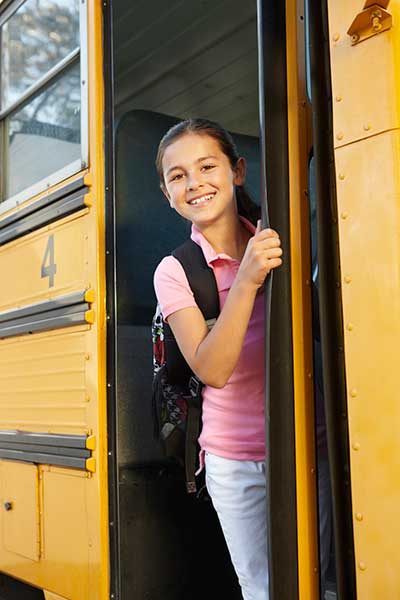
Education systems are stubbornly hard to improve. Would it work better to blow them up?
In This Lesson
How big is California's education system?
How many students are in school?
How difficult is it to change the education system?
★ Discussion Guide
Education is big
Big problems require big solutions, right? In the first Trump administration, the leading shock therapy idea for improving educational outcomes was to deploy the power of market forces. Empower parents to choose their schools, the argument went, and schools and will gradually get better in order to compete for enrollment. As Ed100 Lesson 5.5, explains, charter schools have provided some evidence to support this theory of change, but their results haven't been massively different on a widespread basis.
In 2025, the second Trump administration declared that it would pursue an even bigger version of the "blow it up" theory of change: massively subsidize private and religious schools to displace enrollment in public schools. As a matter of public policy, there is no evidence that this top-down strategy can produce magical results.
Calls to "blow up" the education system (or, more politely, to re-invent it) generally paint over the challenge of scale. Perhaps because classrooms are small, it is hard to internalize the reality that America’s education system is really, really big. Giant, actually. In rough numbers, nearly 60 million students in America attend grades pre-K to 12. Another 20 million or so are enrolled in college or graduate education. School systems in America employ about 3.6 million teachers for K-12, and spend about a trillion dollars per year. Picture a classroom. There are roughly forty million of them in America. These are big numbers, certainly. But are they bigger than other big things in America? For example:
- Q1: Which does America have more of: teachers or soldiers?
- Q2: Does America have more schools or Starbucks?
Roughly a quarter of America's population is currently enrolled in school.
The answers are not close. America has far more teachers than soldiers, even if you count teachers sparingly and soldiers generously. There are about ten schools for every Starbucks.
Change is hard, and disruption carries risk. It's easy to make mistakes, so systems don't change quickly - at least not without destructive consequences. Educating a child is a long process involving a lot of humans.
Change is inevitable
Public education has changed more over time than most people realize. Lesson 1.7 discusses some of the major themes of the last 100 years of education change in America, particularly the developing ideal of "universal" education. The challenge, of course, is that big ideas and major changes unfold over time. Kids grow up waiting on the world to change, including the world of school.
Nevertheless, if there is consensus about anything in education, it is that change is both necessary and inevitable. Many classrooms still look about like they did fifty years ago. Is it really imaginable that students will still sit in rows, doing the same workbooks at the same time 50 years from now?
Learning already happens differently today. When students really want to know something, they Google it, or ask an AI. The world’s best teachers of many subjects are only a click away. When they want to learn how to do something, they turn to YouTube. With the help of all of this technology, surely education outcomes will improve, right?
Blow-it-up proposals — calls for sudden, widespread change in schools — tend to misdiagnose the role of teachers, as Derek Muller (Veritasium) explains in the video above. Students learn when their brains are turned on. Yes, teachers transmit information to students, but more importantly they inspire and persuade students to do the effortful, essential mental work of learning. Education systems cultivate individual relationships that guide, inspire and reinforce this mental work at massive scale.
Systems resist change
Change tends to happen slowly in education. At least three kinds of inertia resist change:
Policy inertia. Many aspects of education are governed by detailed laws, for reasons good and otherwise. The workings of governments tend to be slow, and movements toward change in one area can be blocked by opposition in another. In 2009, policy gridlock in California had become so frustrating that a movement led by the Bay Area Council called for a California Constitutional Convention. The basic idea was to provoke a bold rethinking of the policy apparatus of the state. A related suggestion "in the mix" at the time called for the entire California education code to be scheduled to sunset (expire automatically) over a period of years unless affirmed by legislation. These calls faded with the successful implementation of multiple reforms including the Local Control Funding Formula (LCFF) and the Top Two Open Primary Act.
Organizational inertia. The "ecosystem" of education includes many participants with different perspectives, such as teachers, parents, students, businesses, unions, and taxpayers. Changes that require policy action must survive the policy process. Even at the nominal "end" of a policy decision process, changes only affect students to the extent that they are carried out.
Human inertia. A new set of standards does not automatically change lesson plans, or the materials a teacher uses to explain an idea to students. Just because a teacher receives new software does not mean that he or she wants to use it, or knows how. In many schools, teachers feel that they are expected to work miracles with nothing but chalk and charm.
Clearly, big systems don’t tend to change spontaneously. In education, what are the conditions that can overcome inertia and make change happen? The next two lessons examine two competing ideas about the role of resources in education change. Would efforts for change be better served by massive investment or by a tightened belt?
Updated June 2025
CHAPTER 10:
So Now What?
-
So Now What?
Overview of Chapter 10 -
Should the Education System be Blown Up?
Would Disruption Help? -
What if Schools Had More Money?
What Do the Rich Schools Do? -
Are Lean School Budgets Good for Kids?
Do Lean Budgets Make Schools More Innovative? -
Change
What Causes Change in Education? -
Learn More About Education
Organizations and Resources
Related
Sharing is caring!
Password Reset
Search all lesson and blog content here.
Login with Email
We will send your Login Link to your email
address. Click on the link and you will be
logged into Ed100. No more passwords to
remember!














Questions & Comments
To comment or reply, please sign in .
Sonya Hendren June 11, 2020 at 12:45 am
Now is the time to make big changes!
Sonya Hendren June 11, 2020 at 12:42 am
Mary Perry June 25, 2014 at 10:59 am
For the urgency part, I like this article, http://blogs.kqed.org/mindshift/2014/06/employers-challenge-to-educators-make-school-relevant-to-students-lives/ that challenges educators to make school more relevant. It really puts students at the center of the question of education change -- right where they should be.
The article was posted on Mindshift (at http://blogs.kqed.org/mindshift ) which provides a wealth of ideas -- from many different points of view -- about what's possible.
Here's how the Mindshift blog describes itself: "Launched in 2010 by KQED and NPR, MindShift explores the future of learning in all its dimensions, covering cultural and technology trends, innovations in education, groundbreaking research, education policy, and more." Credible source and challenging ideas. It's worth a look.
Sonya Hendren September 2, 2018 at 7:54 pm
Gisele Huff May 20, 2011 at 9:43 am
As someone who has been in the trenches for more than 12 years, I am no longer talking about reforming education but about transforming it. As a matter of fact, I am no longer talking about education but about learning. That shift in vocabulary places focus squarely on the child and not on the adults or the system. In that space, personalized, differentiated learning rules and can only be delivered through technology.
In my view, learning should be bifurcated between content and pedagogy. Children learn content on the computer, adaptively, at their own pace. The software tracks their progress, evaluates their performance, intervenes when necessary, and creates a profile of their activities that is instantaneously available to the teacher through a dashboard. The teacher is Socrates, helps the students connect the dots and go deeper into the material they have learned on the computer.
In this scenario, as it is practiced at the Carpe Diem School in Yuma, AZ and at two 5th grade and two 7th grade classes in the Los Altos School District that use a Khan Academy math curriculum, the teacher has much more time to spend with each student individually. Not having the responsibility for imparting content to a group of children with varying abilities and particular learning problems, the teacher can now personalize the necessary intervention on the spot, as it were. No one falls through the cracks, no stitch is dropped.
That is the future of learning and the salvation of this country if we are to continue competing in the global economy.
Mamabear April 12, 2015 at 2:25 pm
See below:
use a Khan Academy math curriculum, the teacher has much more time to spend with each student individually. Not having the responsibility for imparting content to a group of children with varying abilities and particular learning problems, the teacher can now personalize the necessary intervention on the spot, as it were. No one falls through the cracks, no stitch is dropped
Caryn-C September 18, 2017 at 10:59 am